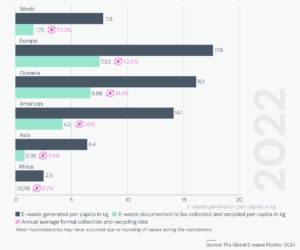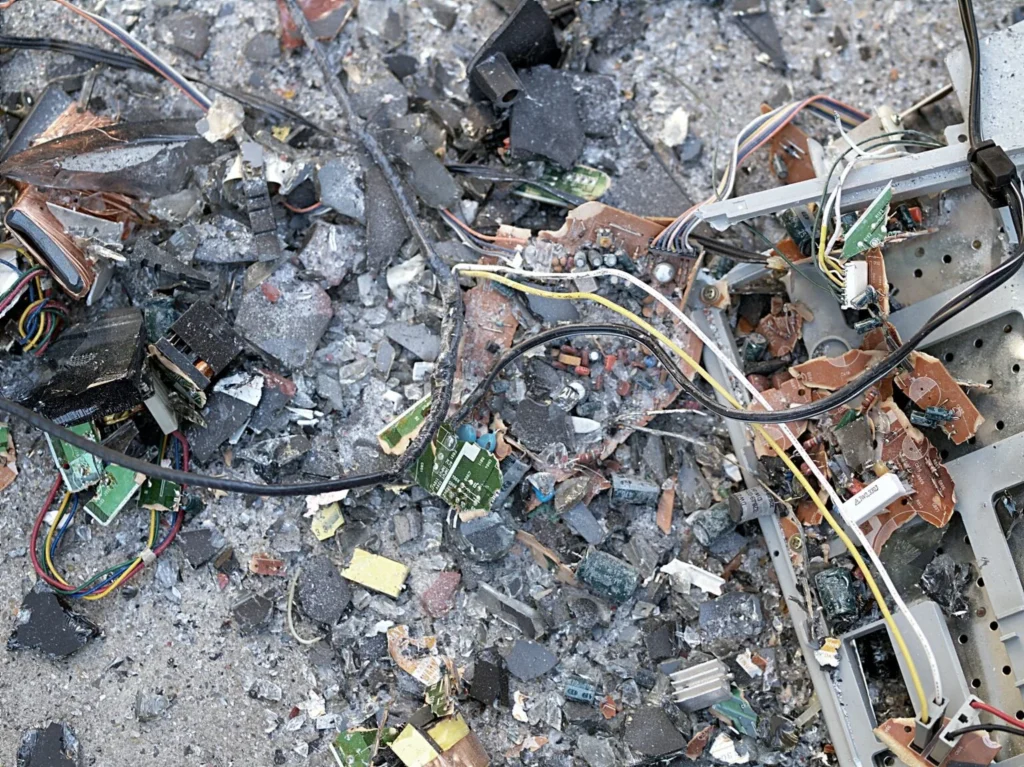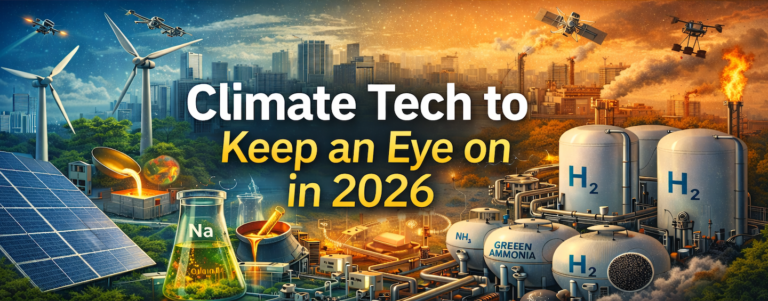The 62 million tonnes of e-waste generated in 2022 would fill 1.55 million 40-tonne trucks – a bumper-to bumper trucks encircling the equator. IoT 102% increase projected for 2030.
(A follow-up from FNGN June 2024 E-Waste Article)
The Global E-waste Monitor 2024 report , issued in collaboration with the United Nations, is alarming. Waste Electrical and Electronic Equipment (WEEE), commonly known as e-waste causes Environmental and Health Risks.(continue reading)
Japan, South Korea and some European Countries are Approved Facilities: E-waste that is exported is typically sent to facilities in countries with the capacity to process it safely and efficiently
The number of Internet of Things (IoT) devices worldwide is projected to nearly double from 15.9 billion in 2023 to more than 32.1 billion by 2030 (Statista) to exceed 80 million metric tons, Improved recycling and recovery infrastructure will be needed.
This represents an approximate 102% increase over this period. This rapid growth is driven by the increasing adoption of smart home devices, wearable technology, and industrial IoT applications.
- There is over 347 (million metric tons) Mt of unrecycled e-waste on earth in 2024.
- China, the US, and India produce the most e-waste.
- Only 17.4% of e-waste is known to be collected and properly recycled.
- Only 78 countries have any form of legislation for dealing with e-waste.

Planned obsolescence is a strategy where products are designed to have a limited lifespan, encouraging consumers to purchase replacements more frequently, justified by companies as a way to keep up with technological advancements and consumer demand. The push back from big global electronic brands are the need for frequent software updates, and 5G internet, that may slow down and affect the performance of older devices. And, newly released versions of products, making older models less appealing to keep making older ones seem outdated
Advocate for legislation for a more sustainable future where products are designed to last and be repaired, rather than discarded.
Legislation and Regulation and Incentive Programs: Enacting comprehensive laws and regulations to guarantee effective e-waste management and disposal involves establishing recycling rate targets, prohibiting e-waste from being dumped in landfills, and imposing penalties for non-compliance. And providing incentives to encourage consumers to recycle their outdated electronics through trade-in programs, discounts on new purchases, or financial rewards, would motivate responsible e-waste disposal.
The Extended Producer Responsibility (EPR) policies introduced in the early 1990, manufacturers are now held accountable for the entire lifecycle of their products. Japan and Europe lead the way, shifting the responsibility of end-of-life management of products from consumers and municipalities to the producers.
Top examples:
Apple: Under EPR regulations, Apple has implemented recycling programs and offers trade-in options for old devices.
Samsung: Samsung participates in take-back programs and has initiatives to recycle and refurbish old electronics.
HP: HP runs a Planet Partners program, which focuses on recycling and reusing printer cartridges and hardware.
Sony: Sony has established take-back and recycling programs for its electronic products.
Unilever: In the consumer goods sector, Unilever has committed to making all its plastic packaging reusable, recyclable, or compostable by 2025.
But there are strategies consumers can use to extend the lifespan of their electronics and make more sustainable choices:
Research Before Buying: Look for reviews and reports on the longevity and reliability of products. Websites like Consumer Reports and forums can provide valuable insights. Choose Durable Brands: Some brands are known for their durability and long-term support. For example, companies like Fairphone focus on sustainability and repairability. Maintain Your Devices: Regular maintenance, such as cleaning and updating software, can help extend the life of your electronics. Repair Instead of Replace: If a device breaks, consider repairing it instead of buying a new one. Websites like iFixit offer guides and tools for DIY repairs. Buy Modular Products: Some products are designed to be easily upgraded or repaired. Modular smartphones and laptops allow you to replace individual components rather than the entire device. Avoid Unnecessary Upgrades: Don’t feel pressured to upgrade to the latest model if your current device still meets your needs. Support Right-to-Repair Legislation: Advocate for laws that require manufacturers to provide parts and repair information to consumers and independent repair shops. Recycle Responsibly: When a device truly reaches the end of its life, recycle it properly to ensure valuable materials are recovered and environmental harm is minimized.
ENVIRONMENTAL IMPACTS
Soil and Water Contamination: Affect local ecosystems with toxic substances like lead, mercury, and cadmium and potentially enter the food chain.
Impact on Marine Life: This pollution can disrupt aquatic ecosystems and affect species that are crucial for maintaining ecological balance.
Air Pollution: Incinerating e-waste to recover valuable metals releases harmful chemicals into the air, including dioxins and furans.
Loss of Valuable Resources: E-waste contains precious metals such as gold, silver, and platinum. leading to increased mining activities which further harm the environment.
Hazardous Waste: Improper handling and disposal can lead to the release of these hazardous substances, posing risks to both the environment and human health.
HEALTH ISSUES
Neurological Effects: Exposure to heavy metals like lead and mercury can impair cognitive development, especially in children. This can result in reduced IQ, attention deficits, and behavioral problems.
Reproductive Health: Toxic substances in e-waste can affect reproductive health, leading to reduced fertility and adverse pregnancy outcomes such as stillbirths and premature births.
Cancer: Some chemicals released from e-waste, such as polycyclic aromatic hydrocarbons (PAHs) and brominated flame retardants, are known carcinogens and can increase the risk of cancer.
Thyroid Dysfunction: Exposure to certain e-waste components can disrupt thyroid function, which is crucial for metabolism and growth.
DNA Damage: Toxic substances from e-waste can cause DNA damage, which may lead to various chronic diseases and developmental issues.
Children and pregnant women are particularly vulnerable to these health risks due to their developing bodies and higher absorption rates of toxic substances.
AUSTRALIA:
Product stewardship schemes support the environmentally sound management of products and materials over their life/ to end of life. Everyone who imports, designs, produces, sells, uses and disposes of products has a shared responsibility to reduce the environmental and human health and safety impacts of those products.
In 2019 Australia generated 511,000 tonnes of e-waste. That means the average Australian produced 20 kg of e-waste, compared with the global average of 7 kg.
By 2030 the national total is projected to rise by nearly 30%, to 657,000 tonnes.
Australia only recovers a third of the total value of the materials in the e-waste we generate. This means in 2019 alone, Australians sent $430 million worth of materials to landfill along with their e-waste. As well as valuable substances, e-waste contains hazardous materials. These include lead, cadmium, mercury and persistent organic pollutants (POPs). (dcceccw Gov)












